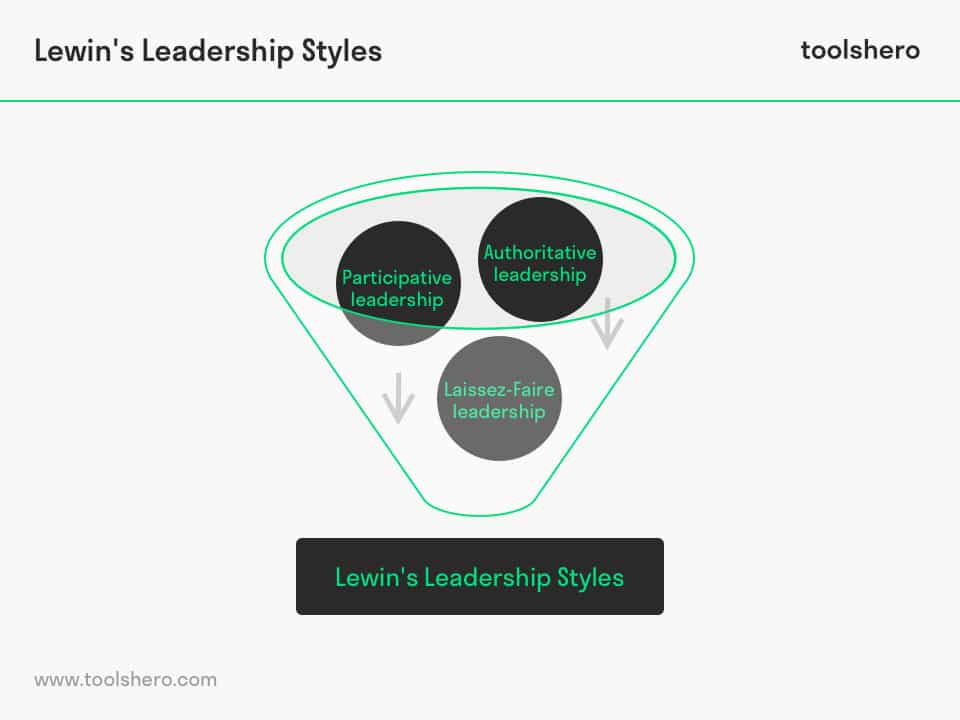Lewin’s Leadership Styles

Lewin’s leadership styles: this article will give you a practical explanation of Lewin’s leadership styles, developed bu Kurt Lewin. After reading this, you’ll have better insight into the three different leadership styles developed by Kurt Lewin.
What are Lewin’s leadership styles?
Kurt Lewin’s leadership styles framework is a somewhat older one, as it debuted as early as 1930. However, it’s still relevant today because it divides leadership styles in to three easy-to-remember groups.
Those three leadership styles are as follows:
Authoritative leadership
This leader is a person who takes charge and isn’t interested in delegating decision-making responsibility to other members of their team. An authoritarian leader takes decisions independently and is convinced that they are the right ones.
They don’t take team members’ feelings into consideration. There’s little interaction between the leader and the team members. The leader gives orders and sets objectives for the team, along with specific instructions on how to carry out those orders.
The authoritative leadership style has both positive and negative effects. One of the positive ones is that it can be an effective strategy when working with inexperienced teams.
Such teams lack the knowledge to take on a more autonomous role in the project. If a team consists of people who require specific instructions to properly carry out their assignment, an authoritarian leader might be the best choice.
On the other hand, an experienced team might resist this type of leadership because it doesn’t offer them the freedom and creativity they feel they deserve. It’s important that the leader carefully assesses the team members before deciding how to best guide them through a task.
Participative leadership
This leadership style is also referred to as the democratic style. The leader expresses their priorities and values when setting goals and making decisions, but also does his or her part in the group’s work and is open to advice and suggestions from colleagues. The leader is still the one with final say, however. In general, this type of leader is appreciated more by team members because they see him or her as one of them.
In the case of an inexperienced team like in the previous example, participative leadership isn’t always the right choice.
Without strong leadership, their lack of experience could turn into a major problem. A team with moderate experience and plenty of enthusiasm, on the other hand, would be an excellent fit for this option. As long as there’s enough knowledge in the group to keep the project on track, the participation of the leader should only improve productivity. The team members will also remain more engaged and motivated because they feel invested as part of the process.
Delegative / laissez-faire leadership
These leaders offer their team members lots of freedom regarding how they go about their job. They offer support in the form of resources and advice, but don’t get involved beyond that. The leader has complete confidence in their team and will enable them to complete the assignment.
It’s important to note that the laissez-faire leadership style requires a good, experienced team. An inexperienced team, or a team that’s not properly motivated or focused might use the freedom offered by leadership delegation to go outside their task and fall behind on project deadlines.
Lewin’s three leadership styles can each be successful, provided they are used at the right time and place. It’s therefore important to first observe the group before employing a specific leadership style. As the group evolves and changes over time, the leadership style will have to be adapted to the needs of the team as a whole.
Why Lewin’s leadership styles?
Through a number of experiments, Lewin established that he was a participative leader, which is the most effective leadership style according to him. Excessively autocratic styles foment revolt, while laissez-faire leaders weren’t consistent in their work, and their team members didn’t show the same level of energy when they were being led actively.
Getting started with Lewin’s leadership styles
Authoritative leaders
All decision making is up to the leader. Authoritative leaders are often associated with dictatorships.
Pros of authoritative leadership
- The decision-making process is quick: with just one person making the decisions, no consultation is required, which means decisions can be taken without delay.
- Motivated managers: the style ‘leading is watching’ motivates managers to work hard.
- Less stress for managers: when a leader is always present, managers feel that they always have access to him.
Cons of authoritative leadership
- Communication usually only happens in one way: this can be frustrating for employees because they only get feedback on their work when they make a mistake.
- Fear and resentment: people don’t like being the boss, and in addition employees receive a lot more criticism than praise, resulting in feelings of anxiety and negativity.
- Culture of dependency: employees will become dependent on the fact that their leader has all the ideas and makes all the decisions, possibly leading to reduced initiative by employees.
When to use the authoritative leadership?
Authoritative leadership can be very effective, for example for short projects that are very complex, or for projects that have a hard deadline. Projects that don’t require skilled employees, employees who need the guidance of a leader to be productive, are also suitable.
Participative leaders
This leadership style involves sharing responsibility for decision making.
Pros of participative leadership
- Pleasant work environment: employees at all levels feel responsible for challenging themselves. Employees are given more opportunities to enjoy their work.
- Less mistakes: because consultation takes place before decisions are made, there’s less risk of the leader making a bad decision.
- Creative culture: employees who are encouraged to take initiative and propose ideas for problem solving.
Cons of participative leadership
- Slow decision making: making decisions takes longer because people have to be consulted first.
- Leader hidden within the group: if the leader is insecure or weak they can often hide this by having the group make all the decisions.
When to use the participative leadership style?
Participative leadership is particularly effective in businesses that apply continuous process improvement, as everyone will be encouraged to support this process of constant improvement. It’s also suitable in highly competitive and complex industries, where it helps the best ideas to reach the surface.
Laissez-faire leaders
With this leadership style, the leader does not lead directly. Instead the group makes the decisions.
Pros of laissez-faire leadership
- Freedom of direction: when employees are motivated to successfully execute the project, the laissez-faire leadership style can offer them the flexibility to do that. That’s because there’s no interference from the leader.
- Less work for the leader: with the responsibility being borne by the group, there’s less work for the leader. Instead, leaders can spend that time on adding value for the organisation.
Cons of laissez-faire leadership
- High levels of stress: employees might feel stressed if they’re not sufficiently confident as a result of the leader’s absence and lack of positive reinforcement.
- Lack of ownership: there’s no one to be held responsible for or take credit in the event of failures or successes.
When to use laissez-faire leadership?
The use of laissez-faire leadership is often only appropriate for a team of very effective professionals with a reputation and history of delivering excellent work.
Now it’s your turn
What do you think? Do you recognise the explanation of Lewin’s leadership styles, or do you have anything to add? When do you think these leadership styles can be effective? What do you believe are success factors that contribute to the practical application of this theory?
Share your experience and knowledge in the comments box below.
More information
- Ferguson, E. D., Hagaman, J., Grice, J. W., & Peng, K. (2006). From leadership to parenthood: The applicability of leadership styles to parenting styles. Group Dynamics: Theory, Research, and Practice, 10(1), 43.
- Chou, S. Y. (2012). Millennials in the workplace: A conceptual analysis of millennials’ leadership and followership styles. International Journal of Human Resource Studies, 2(2).
- Molero, F., Cuadrado, I., Navas, M., & Morales, J. F. (2007). Relations and effects of transformational leadership: A comparative analysis with traditional leadership styles. The Spanish journal of psychology, 10(2), 358-368.
How to cite this article:
Sari, J. (2020). Lewin’s Leadership Styles. Retrieved [insert date] from toolshero: https://www.toolshero.com/leadership/lewin-leadership-styles/
Add a link to this page on your website:
<a href=”https://www.toolshero.com/leadership/lewin-leadership-styles/”>toolshero: Lewin’s Leadership Styles</a>
Published on: 17/02/2020 | Last update: 16/02/2022













